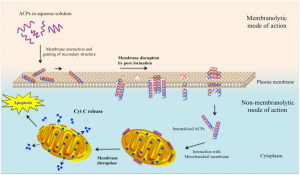Cancer is a major cause of death in economically developed countries which affects millions of people and it is caused by the growth and the spread of abnormal cells in an uncontrolled manner (Arnold et al., 2015). Antimicrobial peptides (AMP) are the part of innate immune defense mechanism. It is identified as the most promising alternative to conventional molecules used nowadays against infections (Hancock et al., 2016). AMPs also display anticancer activities because of their ability to inactivate a wide range of cancer cells. Some of them have been shown to have dual activity; both as antimicrobial and anticancer peptides (ACPs). Swedish scientist, Boman first found and determined primary structure of the antimicrobial peptides from Hyalophora cecropia in 1972 and found it to have anti-tumor activity. The antimicrobial peptides which have anti-tumour activity are called as anticancer peptides (ACPs). They contain 12–50 amino acid residues and some of these peptides are present in membranes with α -helical or β -sheet structures and the others have particular folds.
Properties of anticancer peptides
Anticancer peptides have several extraordinary properties compared to other small organic molecules and proteins, such as low immunogenicity, small size, high activity, good biocompatibility, diversity of sequence and more modification sites for the functional molecules.
Mechanism of the action of anticancer peptides
The mechanism of action of anticancer peptides includes: necrosis by the cell membrane lytic effect and non-membranolytic. It can act specifically against cancerous cells by either membranolytic mechanism or disruption of mitochondria. There were several hundred peptide candidates in clinical and preclinical development, some of them targeting cancer. Drug resistance, altered biodistribution, biotransformation, and drug clearance are the common problems encountered in cancer therapies but the discovery of protein receptors, peptide receptors and tumor-related peptides and proteins as well as host defense peptides, among others which may lead to the creation of a new wave of more effective and selective anticancer drugs hopefully exhibiting less side effects.
. Till now more than 2750 AMPs have been found and 199 of them exhibited anticancer activities. Some ACPs come from the AMPs which exhibit similar properties, such as net positive charge, amphipathic conformation, mechanism, etc. Thus, the method for the design of AMP can also be used for the design of ACP. The peptide therapeutics is becoming a promising field to fight against different diseases. ACPs have become promising anticancer drug candidate molecules. But the low stability and short half-life of peptides are the major barriers for the application because most peptides are usually prone to degradation by various proteases in vivo.
Designing of Anticancer peptides
There are various methods of peptide designing and modification to improve the stability, half-life time and specificity of ACPs, which include amino acid substitution, cyclization, hybridization, fragmentation, modification of C- and N-terminal of peptide by polymer or targeting molecules, etc (Cuihua et al., 2016) Amino acid substitution is a useful tool to improve the activity and specificity of ACPs. Amino acid substitution cannot only change the biophysical parameters of ACP, but also influences the activity and stability of ACP, and even alter the mechanism of action of ACP. The full mechanism of action of this peptide against cancer cells has not yet been established, but activity was already confirmed for different cancer cell lines, with very low cytotoxicity against healthy cells. AMP possesses anticancer activity after topical treatment for subcutaneous murine melanoma and in vitro for melanoma, breast and colon carcinomas. The use of solid-phase peptide synthesis to create peptide libraries that allow for the screening for new types of anticancer peptides will surely be beneficial as well in future.
Classification of anticancer peptides
According to the biological effects of ACPs, they can be classified into three groups: Inhibitory activity, necrostic activity and apoptotic activity. Anti-cancer peptides can be classified into two major groups based on their cell targets. The first one includes peptides active against microbial and cancer cells while not being active against healthy mammalian cells, such as cecropins and magainins. The second group contains ACPs that act against all three types of cells: microbial, normal and cancerous (Hoskin and Ramamoorthy, 2008), such as human neutrophil defensins HNP-1 to 3 (Papo and Shai, 2005; Droin et al., 2009).

Figure: Mechanisms of ACP’s action
Source: Tyagi et al. (2015). Nucleic Acids Research, Vol. 43, Database issue D837–D843
Cancer PPD: Database for anticancer peptides and proteins
Cancer PPD is a unique resource which provides detailed information related to experimentally verified anticancer peptides (ACPs) and proteins and it also provides information related to various chemical modifications like non-natural, D-amino acids, modified-amino acid like ornithine. The database is cross-linked with various other related resources in order to provide comprehensive information related to ACPs. Key features of cancer PPD are as follows, data retrieval, data analysis, browsing and SMILES and structures.
AntiCP: For desigining of ACP
AntiCP is web based prediction server for anticancer peptides. SVM models developed are based on amino acid composition and binary profile features. Positive dataset consists of 225 antimicrobial peptides with anticancer properties. This server is extremely useful for the researchers working in the field of anticancer peptides and it allows the users to design ACPs and their mutants with different physicochemical properties.
Antimicrobial peptides and anticancer peptides have great potential both alone and in combination with conventional drugs which is to be used in infection and cancer therapies mostly due to their effective mechanisms of action on the target cells.
References
- Arnold, M., Karim-Kos, H. E., Coebergh, J. W., Byrnes, G., Antilla, A., Ferlay, J., et al. (2015). Recent trends in incidence of five common cancers in 26 European countries since 1988: analysis of the European Cancer Observatory. Eur. J. Cancer 51:, 1164–1187. doi: 10.1016/j.ejca.2013.09.002.
- Droin, N., Hendra, J.B., Ducoroy, P. ,and Solary, E. (2009). Human defensins as cancer biomarkers and anti tumour molecules. J. Proteomics 72,: 918–927. doi: 10.1016/j.jprot.2009.01.002.
- Hancock, R. E., Haney, E. F., and Gill, E. E. (2016). The immunology of host defence peptides: beyond antimicrobial activity. Nat. Rev. Immunol. 16:, 321–334. doi: 10.1038/nri.2016.29.
- Hoskin, D.W and Ramamoorthy, A. (2008). Studies on anticancer activities of antimicrobial peptides. Biochim. Biophys. Acta 1778:, 357–375.
- Hu, C., Chen, X., Zhao, W., Chen, Y., and Huang, Y. (2016). Design and Modification of Anticancer Peptides. Drug Des. 5: 138. Doi.
- Mário R. Felício, Osmar N. Silva, Sônia Gonçalves , Nuno C. Santos and Octávio L. Franco. (2017). Peptides with Dual Antimicrobial and Anticancer Activities. February 2017 | Volume 5.
- Papo, N and Shai, Y. (2005). Host defense peptides as new weapons in cancer treatment. Cell. Mol. Life Sci. 62: 784–790. doi:10.1007/s00018- 005-4560-2.
Bhanita Devi1*, Leena Das2 and Arundhati Purkayastha3 Department of Animal Biotechnology 1PhD Scholar, LUVAS, Hisar, Haryana 2,3PhD Scholar, College of Veterinary Science, Khanapara, Assam *Corresponding e-mail Id:drbhanita@gmail.com




